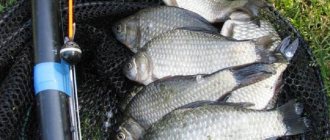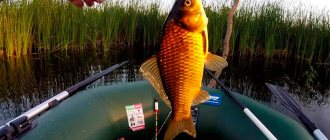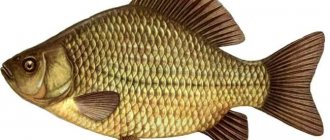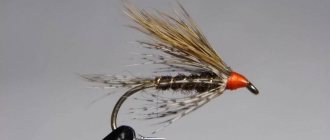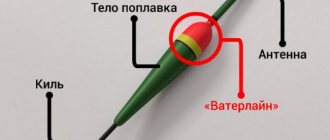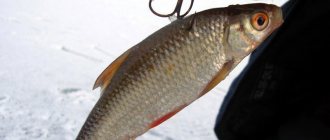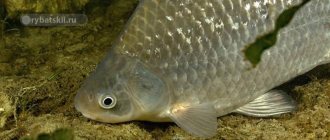For some fishermen, especially beginners, equipping a float rod for crucian carp will seem like a simple matter. What is there - I secured the float, selected the required pellet, and tied the hook. However, nuances arise later - light float or heavy, the diameter of the leashes, the size of the hooks. On the one hand, it bites better on the lungs. On the other hand, in the current and wind, light equipment is blown away. Let's take a closer look at how to properly equip a float rod for crucian carp, depending on the fishing conditions and the personal preferences of the fisherman.
Fishing for crucian carp with a float
The tactical features of fishing for silver (and gold) are discussed in detail in a separate article about catching crucian carp with a float. Here we will dwell on how to correctly assemble a fishing rod for crucian carp with a float, with or without a reel, blind or sliding equipment, light or heavier. That is, we will directly analyze the nuances of equipment, proper loading and types of installations.
Simple and long casting
If you do not take into account match equipment, basically all amateurs use a fly tackle, a fishing rod with a small inertial reel, or a popular version of the Bolognese fishing rod, a Chinese telescope with the same inertia-free reel. A swing or fishing rod with a simple reel is for short casting. Moreover, in the first case, there is no supply of fishing line in the equipment - which is bad when fishing for large fish. But the fly rod is light and comfortable. For catching even large crucian carp on a float, this tackle is perfect - if you don’t need to cast far and there is no chance of the carp biting.
- If you make a fishing rod for crucian carp with a spinning reel, in addition to the near zone, it becomes possible to make long casts. And here, the better the reel and rings, the thinner the line and the heavier the equipment, the further you can cast.
- Even the cheapest Chinese reel on a regular 4-5 meter fishing rod with a 0.14-0.18 mm fishing line perfectly casts a rig from a 2 gram float at a distance of 10-20 meters. True, to do this you have to sand the seam on the reel spool with zero-grade sandpaper so that it does not slow down the line, and have good experience in casting light rigs from behind the back in a swoop. Usually on small rivers and ponds this is enough.
- If you need a longer cast, then we use larger floats with a load of 4, 5 or more grams, or even match rig options. Match tackle is not necessarily any special sports tackle. You can make an analogue of it for amateur fishing on the basis of an ordinary telescopic fishing rod with a spinning rod.
- The equipment of a fly rod for catching crucian carp, as well as with a simple reel, and the Bolognese version with a spinning rod are the same, right down to the options for pure match equipment. More precisely, the principle of its correct construction is the same.
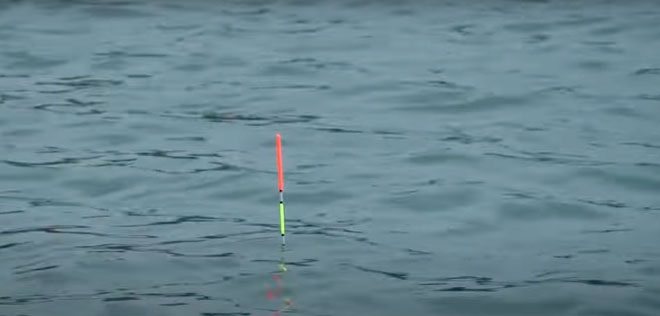
Other options
Now let's look at those rigging options where several hooks are used.
Spring equipment

- The basis of such gear is a spring-shaped feeder , which is twisted from wire 2 mm in diameter. The spring is attached to the end of the main line and has several leashes with hooks. The leashes are also attached to the main line. The spring itself is a weight. This is exactly what she manages to make long casts and also keep the bait at the bottom.
- A viscous porridge or other bait is placed in the spring. Additionally, “nipples” are formed from the bait, which are used to disguise the hooks.
- Fishermen often These are “donut” and “combine”. The peculiarity of the “donut” design is its size of 1.5-2 cm long in the form of a spring, but if you unfold it, it becomes clear that the length of the wire itself is only 5 cm. The diameter of such a spring is 1 cm. The leads are attached around the perimeter.
- The “harvester” is already shaped like a cone , the leashes are attached above the sharp end of the cone. Here the length of the cone is already up to 5 cm (maximum - 6 cm), and the diameter of the base is 1-1.5 cm. Such spring equipment is more sensitive than the “nipple”, but it will also be a bad choice when fishing in silted and algae-overgrown areas.
- You can cast such tackle from a reel or telescopic feeder rods with guide rings.
- The fishing line is either strong or braided , or monofilament.
- To detect a bite, use a nod , a flexible rod tip or a bell, or electronic alarms for carp fishing.
You should not think that springs differ only in shape. They are attached tightly to the end of the main line or made sliding. Small springs are made to slide without using a separate weight for each. In this case, the main sinker is fixed above the first sliding spring.
All springs have their own travel range along the line. The range boundaries are fixed on both sides with stoppers.
The rod is selected 2.5-3.5 meters. The test load of the rod is 40 grams and no less. Choose a spinning reel from 2000 to 6000. The thickness of the fishing line is suitable from 0.25-0.3 millimeters. Hooks are selected simply according to the bait used. As a convention, it will be No. 7-8. The length of the leash is selected at the personal discretion of the fisherman. This is at least 5 cm or can reach as much as 50 cm.
Mounting equipment

This fishing method is simply simple. The fish, attracted by the smell of the top, begins to suck the bait and sucks in the hook.
This method does not require any special fishing skills. To rig the top dog, feeder equipment is used, only instead of a feeder it is equipped with a top box. And the fishing method itself is no different from fishing with a feeder.
So, let's move on to the description of the gear:
- Cargo. Take a dovetail type weighing 30-50 grams for fishing in calm water. If fishing is planned on the current, then a puck weight weighing 100 grams or more is already used.
- Clasp. There is an industrial one and a homemade one made from a piece of wire. It is selected depending on the size of the piece of corn and the leash with which the hook is attached.
- Leash. Select a diameter of 0.18-0.20 mm and a length of 5-7 cm for mounting one hook. In the case of using two hooks on one leash, the length of the latter is made up to 15 cm.
- Hook. You need to focus on the size of the fish: No. 3.5-7.
- Swivel with a latch and a minimum breaking load of 10 kg. The swivel is attached to the loop. Thanks to it, the equipment will be connected to the main fishing line.
Don’t forget about a piece of topcoat measuring 3 cm by 5 cm.
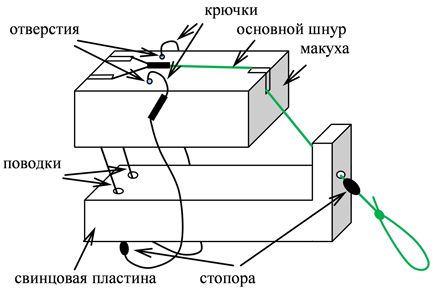
makushchat installation diagram
Installation of the crown is simple:
- First, pass a piece of fishing line (15-30 cm long) through the hole in the weight and knit a loop to attach the clasp with hooks.
- A swivel with a latch is attached to the second end. If it is necessary to protect the knot from the sinker, then attach a bead between them.
- Finally, attach the hook clasp.
The second option is a little more complicated:
- Drill 4 holes along the edges of the rectangular weight. Cargo weight 30-150 grams.
- to one of the outer holes .
- Leads 7 cm long are attached to the remaining holes
- A piece of top is secured with rubber bands or screwed onto a screw screwed into a weight.
Nipple equipment

The simplest pacifier is made from the cork of a 5-6 liter plastic bottle:
- Drill 4 holes along the edges at the same distance. The main fishing line is tied to one hole. To the rest, leashes 5 cm long with hooks size No. 5-7 are attached.
- If a fisherman wants to increase his catch , then attach a spring with 3-4 additional leads to the lid. It is only necessary to take into account that this is done on large lakes.
- The cap is shipped with lead weighing 10-15 grams. To secure the load, use a piece of thin wire or a screw.
Now let's move on to the characteristics of the rod:
- They buy it 2.4-3 m long.
- Select a coil of at least 3000 , but still better than 4500. To be on the safe side, take a reinforced coil. This is for insurance in case a carp bites on the nipple.
- The main fishing line or cord is taken with a diameter of 0.20-0.25 mm.
- To signal a bite, a bell is attached.
Gum equipment
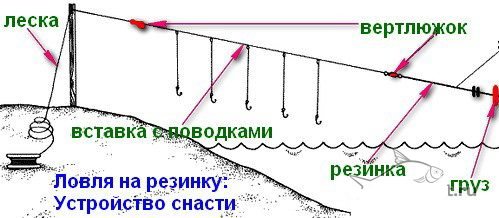
The rubber band (donka) has long been loved by fishermen. In fact, this is a banal bottom fishing rod with several hooks. A rubber cord is used only as a shock absorber to simplify fishing.
Manufacturing:
- or weights cast from lead according to their weight are used as Also, stones are in special bags. Approximately 300 grams of sinker will be enough.
- A piece of fishing line is tied to the load itself and an elastic band with a cross section of 3-4 mm is attached to it. If the fishing takes place in the rapids, then already buy an elastic band with a diameter of 6 mm.
- The calculation of the rubber fragment of the fishing rod to the fishing line is in the ratio 1:5. That is, for 5 meters of fishing line you need to use 1 m of elastic. Plus 1-1.5 meters of elastic to the joint length. The total length is calculated as follows. For example, you plan to fish at a distance of 30 meters. This means they take 6-6.5 (5+1 or 5+1.5) meters of elastic and 25 meters of fishing line.
- The elastic band is connected to the fishing line using a swivel.
- The leashes are attached to the fishing line itself through snap hooks at a distance of 20-25 cm. There are no special subtleties in the length of the leashes. The movement of the carabiners is limited by stoppers at a distance of 3-4 cm. At least 5-6 leashes are attached to one donkey.
- The basic line of the tackle is wound on a reel or reel with some reserve, which in turn is secured to a peg hammered on the shore. Additionally, the second peg is used for short-term fixation of the fishing line when inspecting the gear or removing prey.
- Also, tie an auxiliary safety line with a reserve to the load. This is to pull the donkey out of the water after fishing without wandering into the water.
- The hooks are standard for catching crucian carp , and the smallest feeder feeders without weights are attached between the leashes.
Tackle “crucian killer”
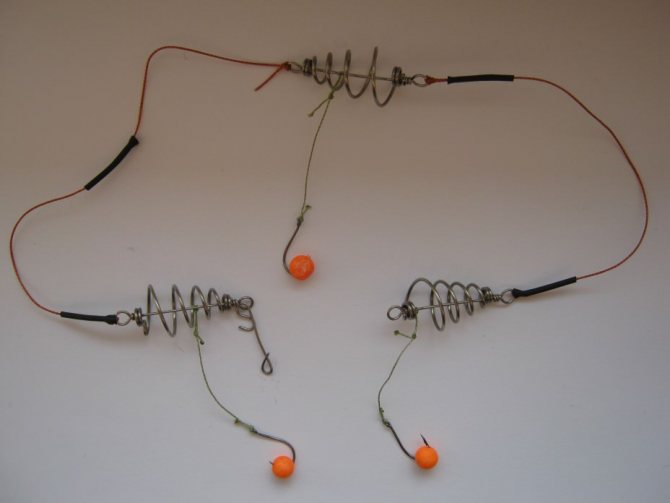
This is rather not a separate type of tackle, but a set of 2-3 feeder springs connected by fishing line (0.4-0.5 in diameter) to each other at a distance of 10 cm.
Manufacturing:
- Instead of fishing line, you can use a cord with a diameter of 0.2-0.3 mm. The springs are stopped with pieces of rubber insulation and matches.
- A 3-5 cm leash with a hook No. 5-8 is attached to each spring.
- The springs are filled with mastyrka or hominy. A foam ball or any other bait is attached to the hooks themselves.
As a piece of advice, we can only add that it is advisable to find the springs with a hollow tube inside to allow the main line to pass through.
Fishing rod equipment for catching crucian carp with a float
In 99% of cases, when using a float rod for crucian carp, you need tackle for fishing from the bottom. When the crucian carp bites boldly and there is a hunger, coarse thick rigs also work. However, in spring and autumn in clear cold water, as well as in summer, when it has already eaten, this fish is often capricious. And he can simply not take the bait, spit it out if, when rising from the bottom, he feels a heavy weight or resistance from the equipment.
The main requirement for equipping a fishing rod for crucian carp is maximum sensitivity. This is a fairly large fish - it easily moves and pulls a weight of 5, 10 grams or more. When it bites well. However, when testing the bait, sensing something is wrong, the crucian carp often stops trying to swallow the bait. Therefore, it is always better to use thin, neat rigs. Since the rude ones only work when they are hungry. The diagrams proposed below for correctly equipping a float rod for crucian carp have been tested over years of practice. And they are simple amateur equipment options, without unnecessary sports bells and whistles and expensive elements.
Blind equipment
Sometimes anglers argue which float equipment for crucian carp is better, blind or sliding. However, I think there is no difference - as long as the float is properly loaded. Mounting a fishing rod on a crucian carp can be done in any way. For long-distance casting, the sliding version is more convenient. Rigging a fly rod for crucian carp is rather a blind option. You can rig a Bolognese fishing rod for crucian carp this way or that way. The depth still rarely exceeds the length of the rod. Blind equipment is simpler, neater and more reliable. No stoppers needed. However, for long-distance fishing with depths of 3 meters or more, the sliding option is more convenient, since the float goes down to the sinker.
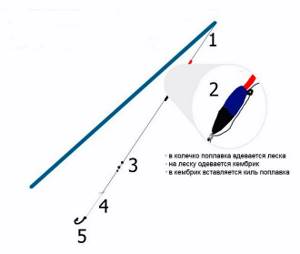
For example, I almost always fish with solid light floats with a spinning reel - even when the depth is under 5 meters. Yes, when casting a rig, when the float is right at the tip, inconvenience arises. But they can be solved by careful and precise casting, training and practice of casting the tackle. So it's more a matter of personal preference. Effective rigging for crucian carp can be done in both cases - this is more about loading the floats, choosing the diameter of the fishing line and hooks. It doesn’t matter how the float hangs, tightly or slides, as long as it’s done correctly.
Usually the float in the blind version is attached to the leg through a pair of cambrics. If there is a ring in the body, we pass it through it too. Also - a feather float, we plant it on 2-3 cambrics of the required diameter. Microfloats with a short keel and antenna can also be attached to one point. It is important here that the float sits firmly on the fishing line, but moves under force to adjust the depth. This is achieved by selecting the diameter of the cambrics and their density depending on the material.
Small floats up to 3 grams are often deaf, while large floats are sliding. However, there are fans of small sliding floats, as well as large deaf ones.
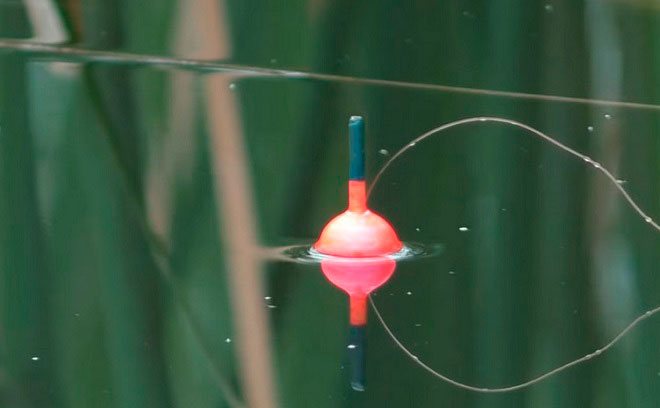
Sliding float
In the sliding version, you can make a float tackle for crucian carp with your own hands from an ordinary blind float. To do this, you need to attach a metal or plastic loop to the leg. Ready-made connectors are also sold. The type of sliding float - with one point or two - depends on the number of such loops. The second ring is usually located in the float body itself.
The line passes through the rings, and the level of the float is adjusted with stoppers. The upper one is for setting the depth, the lower one is so that the float does not fall directly on the load and does not get confused with the leash.
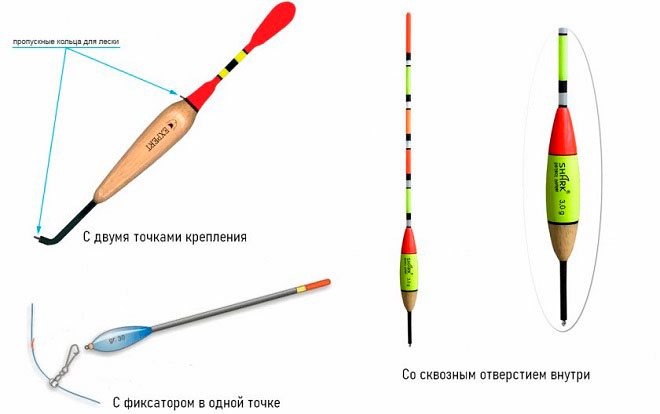
- Rubber stops do not fit into the rod rings. Therefore, in the rigging of crucian carp fishing rods for long-distance casting, which are created for fishing at depths significantly exceeding the length of the rod, you need to use micro-stoppers, special knots that taper in the direction of departure with a cone - so that they pass the rings well when casting.
- In such equipment, the holes on the float itself also need to be small so that the microstop does not slip through. But this is already a rare case. At such depths it is easier to fish with a feeder or donka, so as not to have to worry about knitted stoppers.
- A sliding float with rubber stoppers is a universal tackle. But what is more important here is the correct loading itself, and not the method of attaching the float. A rod for catching crucian carp from the shore is usually 5-6 meters. This is enough for the near zone. But they can also be used for long-distance fishing. A properly equipped fishing rod for crucian carp is not a special tackle for this particular fish. Depending on the leashes and the size of the hooks, you can catch either carp or roach with it.
Detailed article - sliding float for crucian carp
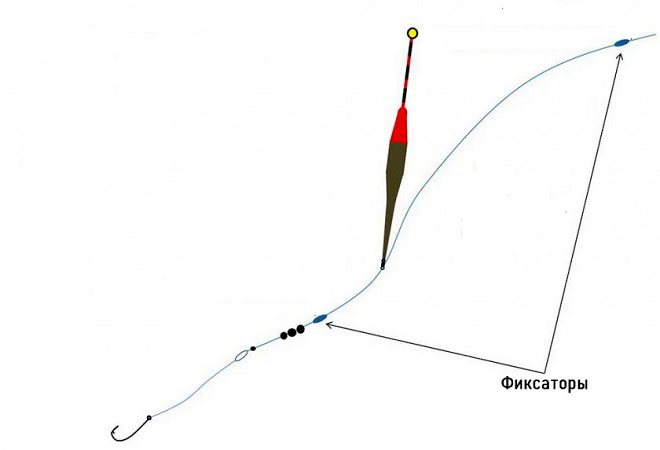
Choosing a reel for crucian carp fishing
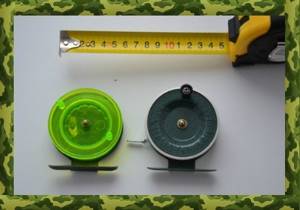
If you are not planning to fish at long distances, then putting a heavy, large spinning reel on your rod will be a very big mistake. But there are also those who think differently, justifying their choice with phrases like: it’s much cooler, it’s much more convenient for others like them. These words do not carry any semantic meaning, just like the use of coils of this type. Using a heavy and bulky reel will be inconvenient and the tackle will lose its lightness. And lightness of equipment is one of the main rules when fishing for crucian carp.
We recommend choosing a regular plastic reel only to store the assembled tackle. When using a match rod, large reels lose their relevance. There are no special requirements for the coil. You just need to choose a more convenient and easier option.
Float for crucian carp
The weight of the float for crucian carp is usually up to 5 grams. 1-2 gram floats are considered light. 1 gram is too little, after all, we’re not catching a hive. The mass of the float for crucian carp is 2-3 grams, or rather, this carrying capacity is just right, the equipment is both sensitive and flies normally on long casts. What is more important here is not the size of the float itself - but the fact that the pellets in the load do not exceed 2-3 grams. The crucian carp does not feel them in this case when it lifts the rig from the bottom. Heavy floats fly well, however, they work poorly for crucian carp in a weak bite if they are loaded incorrectly (more on this later). So, float size is a matter of personal preference. You can use both large and light ones. However, on large floats it is necessary to use sensitively spaced weights, and not place one heavy weight, otherwise such tackle will only work during a good, bold bite, for example, during the spring run.
I myself always use 2-3 gram floats or a goose feather. And in a strong current, where there is no way to stand, I simply fish with a wire, a tightness at an angle to the shore, by floating, or even with a feeder. With such huge floats, which I sometimes notice among fishermen on the shore, I often catch a predator with live bait, rather than peaceful fish. And I have this type of fishing rod rig - not only for crucian carp, it is the same all year - whether for roach, carp or bream. I change leashes and hooks (for carp, of course, without a leash, the hook is on the main line).
How to choose floats for catching crucian carp
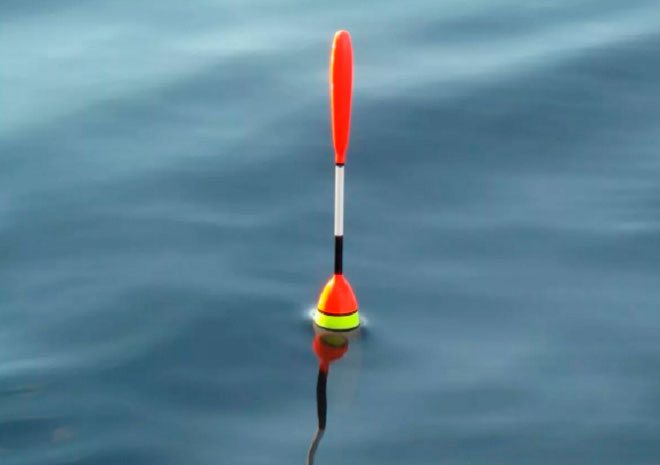
Light float
Light equipment for catching crucian carp with a float rod requires neat, oblong floats with a carrying capacity of 2-3 grams. They are also suitable without an antenna - with a button sticking out of the water. It doesn’t matter whether it’s in a blind or sliding version, it’s not for everyone. I use exactly these to catch any fish with a float, on a five-meter rod with a spinning reel. The choice of float for catching crucian carp based on color and decorative elements is up to the fisherman, as long as he enjoys watching the bite.
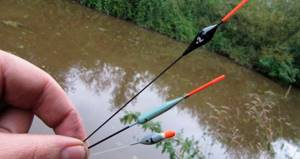
Such a load with this tackle, if desired (and skill), can also be cast for a long cast up to 30 meters (if not against the wind). A regular telescopic fishing rod with rings, 4-6 meters, although the cheapest, is suitable for this. And also a plastic spinning reel for 200-500 rubles. You can, of course, use expensive ones if you wish. We do the same thing both on the swing and on a fishing rod with inertia - it makes no difference, it’s just that long-distance casting will become inaccessible.
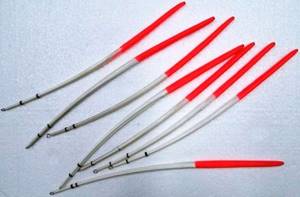
Setting up a fishing rod for crucian carp with a carrying capacity of 2-3 grams is simple - you just need to pick up a pellet and immerse the float almost to the antenna. In this case, several options for use when fishing appear - in the picture these are 1, 3 and 4. Even better - to make a spaced load of two pellets - then tactically another option appears for placing the equipment on the bottom - number 2. And this is what is often needed on a river with a weak current, so that the equipment is pulled slowly with stops.
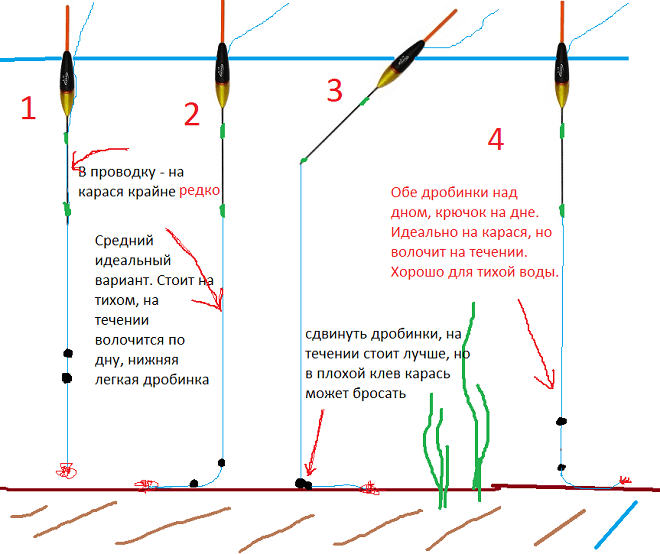
The fisherman’s task is already on the spot - to experimentally select which position of the equipment in the water at this particular place now works better. The method of simply throwing into the water and waiting for someone to bite often does not work. Shots weighing 1-2 grams do not strain the crucian carp when it takes the bait, even during periods of passive and cautious biting. We surround the goose feather in the same way - it has exactly the same load-carrying capacity.

Choosing a fishing rod for crucian carp
When choosing a fishing rod, you should pay attention to several points. I think it’s worth delving into the classification of fishing rods and their differences. Since the topic is very extensive and it needs a whole article. Now let's talk about our personal recommendations on this matter.
We do not use long-range or match rods. For most reservoirs their use is not justified. Fishermen often have long-term disputes over the predominance of fly or Bolognese rods. It is best to choose a classic fishing rod.

The choice of the fly rod option raises some doubts. And the shortcomings of such a fishing rod just confirm those very doubts. Using a Bolognese fishing rod is much more convenient and its operation does not cause the same problems as with a fly rod. After all, a person should relax while fishing, and if it is filled with problems and force majeure situations, then there will be no rest.
If you catch crucian carp using a classic rod equipped with rings, most problems will be easily solved. For example, if your fishing line gets tangled, you can simply cut it off and tie the rig to a normal piece. With a fly fishing rod, such a maneuver will not work, since when fishing with it, the finished equipment is wound on the reel.
An important point is also the depth of the reservoir. And with its different values, the fisherman will need fishing line of different lengths. Sometimes you have to fish at a depth of less than a meter, and sometimes more than three meters. It will be extremely difficult to use the same fly rod for such a range of depths. But we don’t force anyone to use exclusively classics; the choice of rod is still yours. And choose a classic or fly fishing rod or still a Bolognese fishing rod? Only you can answer this question based on your personal preferences.
Presumably, we will choose a Bolognese fishing rod equipped with rings for fishing. An ordinary fishing rod, not a “criminal” and well-promoted brand, will cost relatively little. But you shouldn’t choose the cheapest fishing rod. Undoubtedly, we must pay tribute to simple fishing rods, which don’t even have painted rings; they catch fish well, but not for long. But it is comfortable to fish with them only if their length does not reach four meters. Such rods with a length of more than 5 meters in the hands of the fisherman become simple sticks without any sensitivity. And fishing with such a stick will not bring you any pleasure.
Carbon rods are much stronger and more sensitive. This means that fishing with them is much easier and more interesting. There is no length threshold for such rods and they can be successfully used in versions from 6 meters and above. Often you can find absolutely identical fishing rods on store shelves and on the market, the only difference between them being the sticker and the price. Often the price difference between one and another fishing rod will be quite significant, but the characteristics will be the same. In this case, you should choose the option with an average price.
Heavy float
To load a float onto a large crucian carp, some anglers use one large pellet or olive. However, the crucian carp feels a load weighing 5-7 grams when it picks up the bait. When the fish are hungry or have a good bite, this option often works. However, in the summer, when the crucian carp is full and picky, as well as due to passive biting, this option may not work. Often the crucian carp immediately stops trying the bait, feeling the pressure of the fishing line on the lip under the influence of a heavy weight.
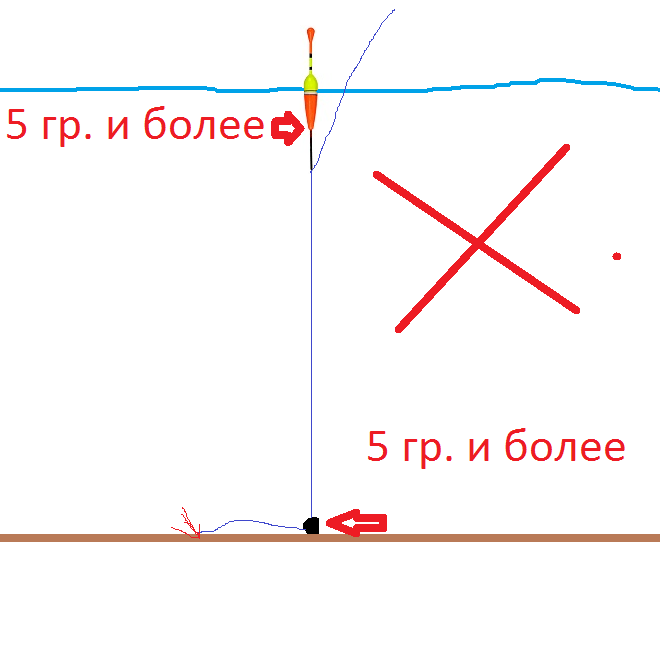
A justified option for using a heavy load is in a sliding version in the current. Here the fishing rod works almost like a half-bottom. When a crucian carp bites, it not only lifts this olive from the bottom - the line also slips, the load between the weight of the equipment and the resistance of the float is equalized.
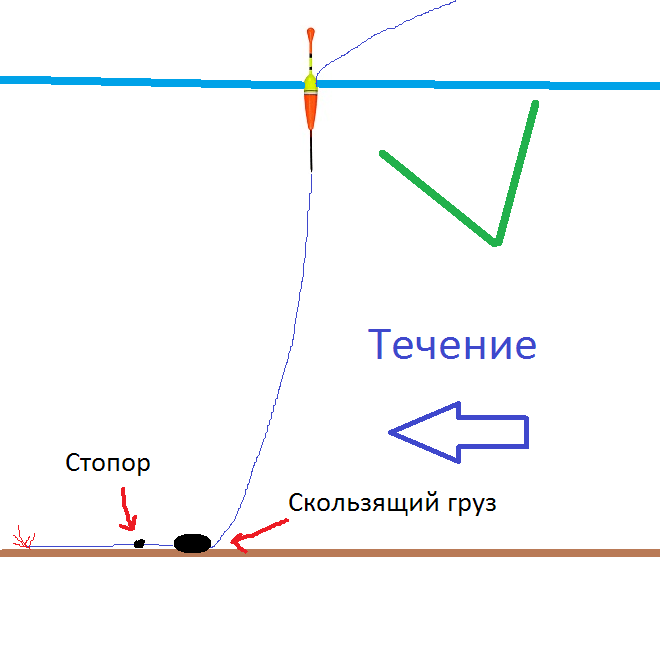
Spaced load
With large floats, if you need them to work not only for a good bite, we use spaced loading. A large load on the line is needed to almost bring the load to the desired value. It is located on the fishing line in the water column, and when the crucian carp lifts the bait from the bottom, it does not participate in this in any way. On the contrary, such a weight even takes on some of the resistance of the float when pulling. But a small supplement weighing 1-2 grams is not a hindrance for crucian carp. We install it in front of the leash, near the hook, in order to load the float up to the antenna. The rising bite in this case will be expressed in the rise above the water of the previously recessed part of the antenna or the body of the float.
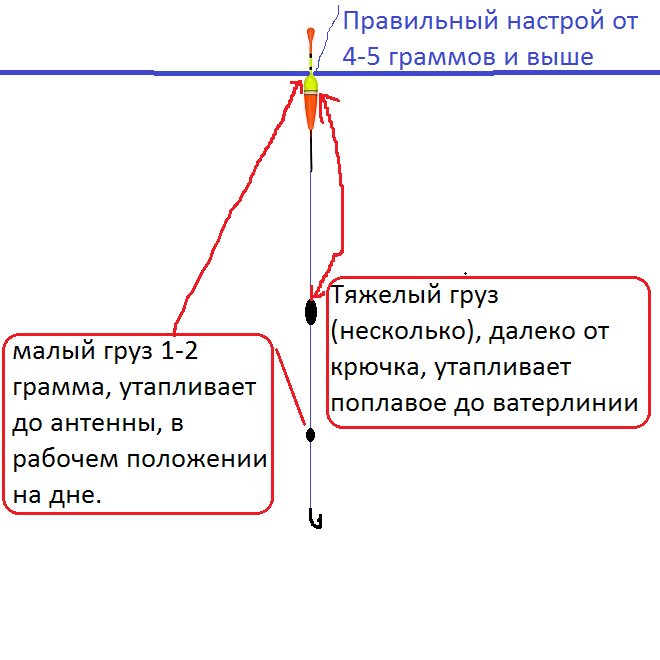
A similar adjustment can be made by selecting the working part of the float on the body itself, or on a long antenna. If the body of the float in the working position is completely under water, then such equipment better resists gusts of wind. And it also works in passive biting, since the crucian carp simply does not feel a large pellet when rising.
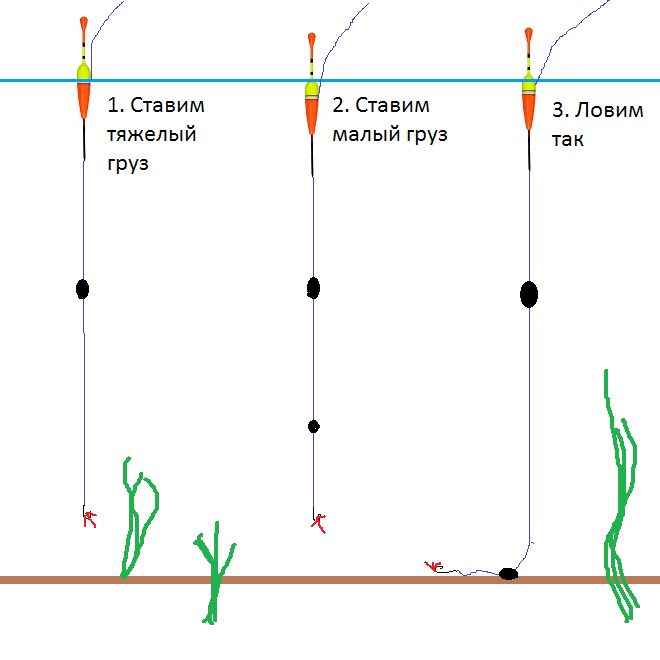
Half-bottom and fishing rod with feeder
Float tackle for crucian carp for the current, with a load exceeding the carrying capacity of the float - this is already a half-bottom. Instead of a load, a feeder is often used. Naturally, the rising bite no longer works here - the float is simply recessed when the fishing line is pulled through the sliding spring. It makes sense to assemble a fishing rod for crucian carp with a feeder during the current, for fishing in the spring - when the crucian carp takes it boldly. Still, this tackle is a bit rough for accurate passive bites.
More details - fishing rod for crucian carp with float and feeder

Line and leashes
- The thickness of the fishing line for crucian carp for a float rod depends on the size of the fish and fishing conditions. For small crucian carp when the bite is poor, thin diameters of 0.08-0.1 mm can be used. For medium crucian carp – 0.12-0.14 mm. In the south, where crucian carp is large, 0.14 mm is probably the lower limit. If there is a possibility of carp biting, then it is better to take a larger fishing line diameter, up to 0.2 mm.
- In the south, where medium-large crucian carp is the main fisherman's trophy - 0.14-0.18 mm. Some use thicker ones, up to 0.3 mm - but such a rope works in the spring when it’s hot, in muddy water. Also, a thick fishing line is needed for catching large fish in the deep reeds - in order to immediately speed up the landing.
- If the main line is thick, then you can simply put a thin leash and move the pellets above it. The length of the leash for crucian carp is selected experimentally, usually 15-30 cm.
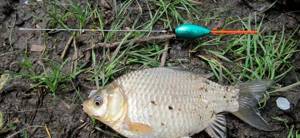
Hooks
There are no correct hooks for catching crucian carp with a float rod, although it is widely believed that it is better to use one with a round shank. As with any other gear, the hook is selected to match the bait that we will fish with. For a bunch of worms, hooks with a long shank are more suitable, for corn - round ones, like mini-carp hooks. For one maggot or bloodworm - small and thin, like a roach. For crucian carp it is better to take thin and sharp hooks - it is unlikely that even a large crucian carp on a fishing rod can break the hook with skillful actions of the fisherman.
It seems that advice to buy expensive hooks from athletes on YouTube is nothing more than marketing and advertising. All my life I have been using ordinary cheap Chinese ones from stores, selecting them according to their appearance, size, visual configuration - and not once has a crucian carp told me that it refuses to bite because the hook is not branded or not catchy.

Float tackle for crucian carp with two hooks
A common question is how to tie 2 hooks to a float rod for crucian carp. Counter question - why? Probably to increase the likelihood of confusion. I have always fished with a fishing rod with one hook, and have never reinvented the wheel.
Still, there may be a positive meaning in the second hook. For example, place a short leash higher so that the nozzle is not at the bottom. However, then most likely it will catch not crucian carp, but perch, roach or bleak circling around the baited spot.
To tie the second hook to a float rod for crucian carp, we use any knots and methods, of which there are plenty on the Internet. The main thing is to make sure that the equipment does not get tangled when casting.
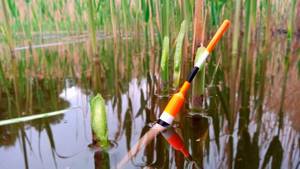
Other gear
Perhaps the most common type of fishing for predatory fish is spinning fishing. A rod designed for such fishing is called a spinning rod, the distinctive feature of which is lightness and small size. It is best to use equipment for spinning fishing that is the same as for bottom fishing gear, with the exception of the equipment.
Instead of a hook and sinker, the spinning rod uses metal or silicone attachments that can lure predatory fish. Such baits are similar in shape to live bait, and their movement in the water does not leave any perch or predator indifferent.
Tackle “crucian killer”
This gear is something between fishing with a “feeder” and a “nipple”. A device of this design is made in such a way that in the center there is a feeder with bait, and at the edges of it there are several feeders with a nozzle. Thus, when a fish bites, mainly crucian carp, self-hooking occurs, as the fish clings to the feeder and the gear moves forward. The uniqueness of this kind of crucian carp fishing lies in self-hooking.
If you want to find out in more detail what they use to catch crucian carp, you can read our article.
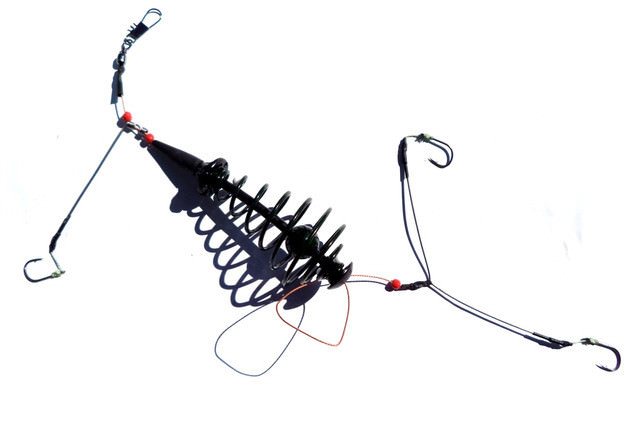
In order to build a “crucian carp killer” tackle you need:
- Tie several springs from the feeder together at a distance of approximately 15 cm. It is best to use fishing lines with a cross-section of 0.2 mm.
- A hook must be attached to each of the springs. It is best if he sits on a leash 8-12 cm long.
- The springs will have the principle of a feeder and should be filled with boiled porridge or bloodworms.
- The hooks are mostly baited with vegetable bait.
Each of the springs must be locked with a special fishing clamp. Then we attach a weight depending on the test rod, and attach a swivel with a hook to the other end of the tackle.
2. Making tackle for catching crucian carp with your own hands
If you are already pretty tired of fishing the traditional way and want some new ways to catch crucian carp, then this article is definitely for you. Tackle that will not let you get bored either when fishing, since this design bites quite well, or on a romantic walk near the lake, because there is an excellent opportunity to please your soulmate with a wonderful fish soup made from crucian carp. This miracle equipment is called “non-missing”.
In order to build this gear we need:
- A small piece of soft wire (about 20 cm).
- Carnation.
- A pair of hooks.
- Pliers.
- A small piece of fishing line.
- Foam balls.
We wrap the wire around one end of the nail so that its tip is hidden. Having bitten off the unnecessary part of the wire with pliers, we retreat 3 centimeters from the first knot and make another knot, only on the back side of the nail.
Then you need to disassemble the ballpoint pen so that its body is empty. Into this body we insert the wire with knots on the tops that we built on the nail. Next, we tie a ballpoint pen with the free end of the wire, making turns (about 5-7 pieces). When we reach the other end of our structure, we will need to cut off the remaining unnecessary part of the wire.
Then we cut off a small piece of fishing line and divide it into two parts (4 cm long). We tie a hook (size No. 6-8) to one end of the fishing line, and connect the other to the knot on our structure. We carry out a similar action with another piece of fishing line.
When the design of the “non-padded pillow” is made, we place two foam balls on the hooks. They are needed so that all the gear floats up, in addition, the foam will act as bait for crucian carp. The equipment is ready! All that remains is to tie a long fishing line to the “no-lost” line and cast it away from the shore.
Match equipment
The correct equipment for a float rod for crucian carp in the match version is made according to the same principle as that for heavy floats. In a purely match version, they spread it even more, placing several weights from heavy at the top to a small underhang in front of the hook. In its pure form, match is a serious tackle on a special rod, with a good reel; special match floats with a weight are used. And, in principle, it’s not just for crucian carp – but for any fish.
Article about match fishing with a rod: link coming soon

In the flood zone of the Cheboksary reservoir
In recent years, crucian carp have begun to be caught even in the flood zone of the Cheboksary Reservoir. As one would expect, after the legendary fishing trips in newly flooded meadows and forests, where the fish fattened in huge schools and were incredibly large, to take either “white” fish or predators, the time came when the shallow waters of the man-made sea began to become swampy, and then aquatic life began to form as quiet as a pond. Already in the sedge, covered with duckweed and greenery, tenches are slurping, ducks are quacking, no, no, and the crucian carp is flashing its wide side in the mud. Moreover, the crucian carp is round and, as they also say, golden or copper. Only, unlike the modest inhabitant of a village pond, this Volga fish is often heavier than a kilogram, as befits a fish of the Volga expanses. For fishing in channels and coastal shallow waters, bottom rocker rigs are used.
Share with your friends!
Summer nod
Another option for equipping a fishing rod for crucian carp is with a nod, without a float at all. This setup works well when fishing local bushes and windows from boats and bridges, especially in spring and summer. A fishing rod for crucian carp and crucian carp with a nod in the south is a fairly common equipment for vertical fishing in water lilies or from a boat in the thickets with a summer jig.
Article about catching crucian carp with a summer nod
